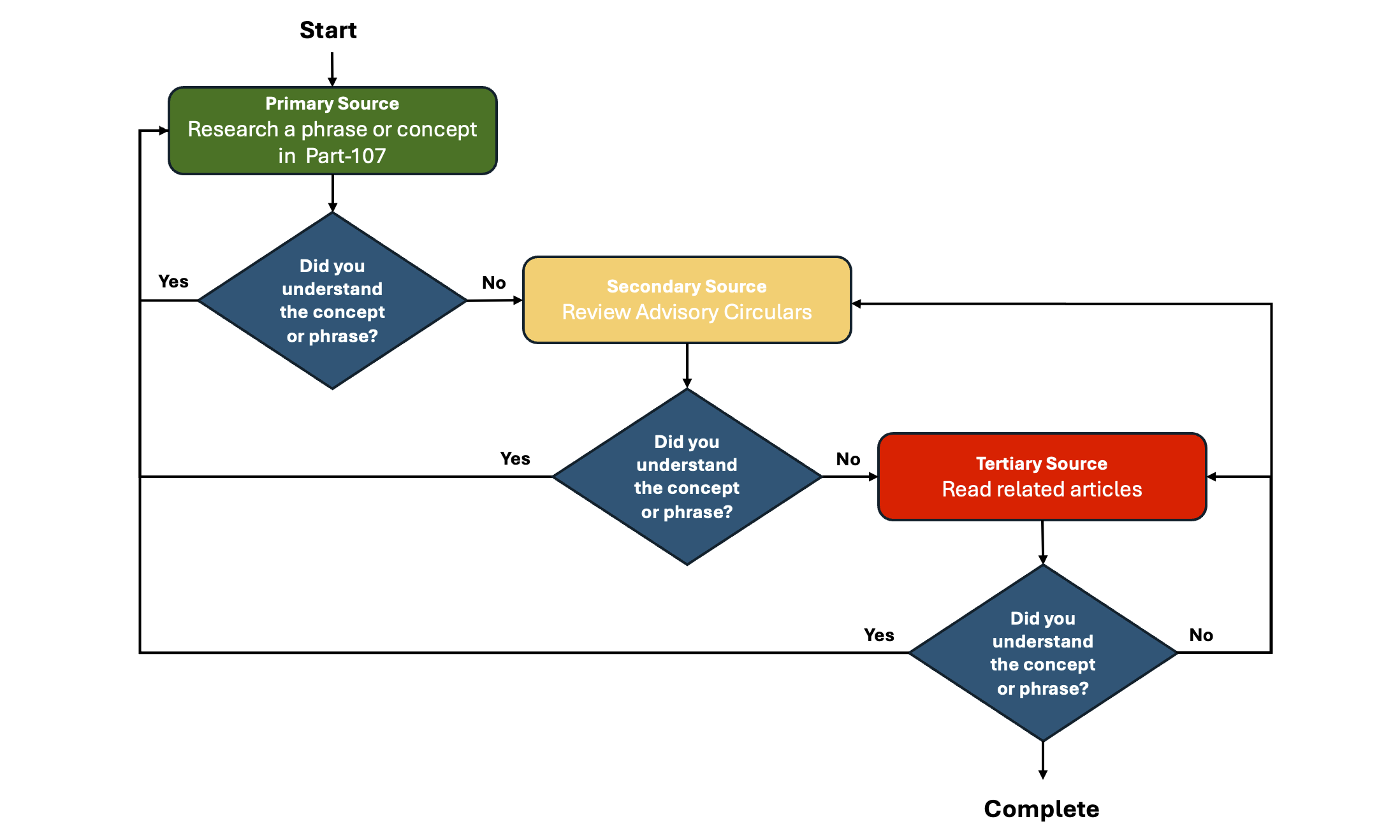Introduction
Excitement is not the first word that comes to my mind when discussing regulations, and with relief, I realize that is okay. Reading and understanding regulations is difficult and time-consuming. Regulation decisions ultimately rest with the courts and regulators, yet they apply to you and your activities as a remote pilot. Piloting a drone is a regulated role. Another way of viewing this is that once you have accepted the responsibility of being a remote pilot, you need to understand exactly what is required to assume the role responsibly and within the rules of the law.
Methodology
At some point in your quest for FAA certification within the United States, you will come upon the phrase part-107[1]. Part-107 is the informal name given to the FAA regulations that govern small unmanned aircraft systems. This term is often the introduction into drone regulation language and culture – it’s a language unto itself, so buckle up to learn more. Regulations have a language and nomenclature specific to their subject area and the FAA (USA)[2] is the source of these regulations. This means the FAA is the primary and go-to source for drone regulation in the USA. FAA regulations are a logical place to start, but be aware that there are other sources, and it is worth discussing the types of sources available to derive facts and access for research. Awareness and understanding of the FAA’s nomenclature is a key tenet to the methodology I have adopted.
Primary Source
The primary source is the regulation itself. However, reading and interacting with the regulation is tedious, error-prone, and interpretations can involve lawyers and legal action to confirm. Yikes! As one can imagine, we do not want to be on the wrong side of any ruling. Inadvertently breaking the law can lead to civil penalties of up to $27,500 and criminal penalties of up to $250,000[3]. Those are not numbers I like at all. FAA regulations provide a great place to start researching the associated nomenclature. One of the first generic sections I started reading was the Definitions section. This is a general definitions section with descriptions of cool things like rockets, powered parachute, unmanned aircraft, and unmanned aircraft systems[4]. In this section, it is possible to see that part-107 is a subcomponent to a much larger and more complex set of regulations: The National Airspace System (The NAS)[5] and the Federal Aviation Regulations (The FARs)[6]. FAA regulations, aka the primary source, is THE single source of truth and absolute source for all facts and definitions regarding part-107.
Secondary Source
This source type can be summarized as interpretive and additive. There is additional value derived from these works through the use of analysis, interpretation and restatement. As noted earlier the regulations are a hard document to read and do not drive adoption. The FAA recognizes this too and provides many secondary sources to aid the remote pilot such as existing Advisory Circulars[7] and handbooks and manuals[8].
- Remote Pilot – Small Unmanned Aircraft Systems Study Guide
- Advisory Circular: Small Unmanned Aircraft Systems (sUAV)
Tertiary Source
These source types are categorized by summarizing, indexing, or listing of other sources. This page would be a good example of a tertiary source. It is important to note secondary and tertiary sources can and do mix.
Visualization
It’s time to visualize how this methodology can work and eventually deepen your knowledge of part-107. I say eventually because a lot depends on the pace you set yourself and I want to acknowledge that!

Conclusion
Pick a term that interests you and start there. The goal is to keep it simple until you are ready to move on. As an example, consider the phrase remote pilot in command. Section 107.19 explains some of the requirements for this role. To learn more, we could use the FAA’s search page[9] and if we don’t understand what we find there, we could search the internet to find additional, informal interpretations. Once comfortable with the concept or phrase, we can go back to the regulation and build on this knowledge. Eventually, we will know enough about how the FAA organizes its information to develop our own approach to certification. You may enjoy tangling with FAA documents, or you may choose to bootstrap it and take a course at a drone flight school. Part-107 certification is not the end of your relationship with the FAA and regulations, but the beginning.
Resources
- https://www.ecfr.gov/current/title-14/chapter-I/subchapter-F/part-107#part-107
- https://www.faa.gov
- https://www.faa.gov/faq/there-penalty-failing-register#:~:text=Failure%20to%20register%20an%20unmanned,for%20up%20to%20three%20years
- https://www.ecfr.gov/current/title-14/chapter-I/subchapter-A/part-1/section-1.1
- https://www.faa.gov/air_traffic/nas
- https://www.faa.gov/regulations_policies/faa_regulations
- https://www.faa.gov/regulations_policies/advisory_circulars/
- https://www.faa.gov/regulations_policies/handbooks_manuals
- https://search.usa.gov/search?affiliate=dot-faa&sort_by=&query=Remote+pilot+in+command
